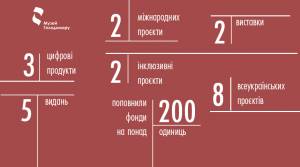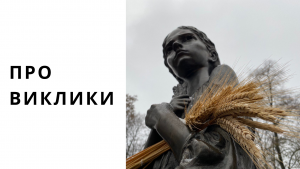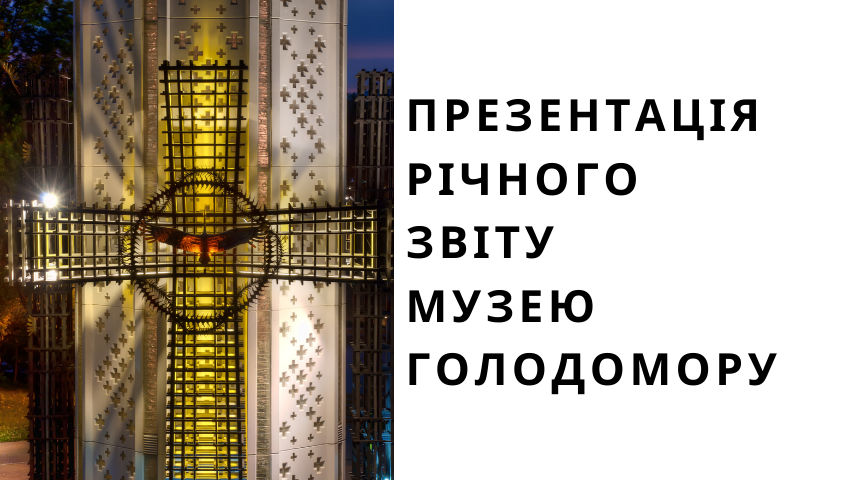Audio giude in 33 languages, two art exhibitions and 10 large projects: the Museum presented its annual report

National Museum of the Holodomor Genocide presented its annual report. Despite the pandemic and challenges, in 2020 the Museum staff managed to:
- implement two international and eight Ukrainian projects;
- present two exhibitions—”Maria” by Canadian artist of Ukrainian origin Lesia Marushchak (the most famous exhibition space about the Holodomor) and “The Way Home” about the world’s first painting about the Holodomor “Year 1933” and its author, emigrant artist Victor Cymbal;
- create three digital products (video tour, audio tour and online educational lesson);
- implement two inclusive projects with the support of Ukrainial Cultural Foundation—adaptation of tour, educational lesson, and web page for visually disabled people;
- publish five editions;
- replenish the funds of the Museum by more than 200 units.
“We believe that the whole world should know the truth about the genocide of Ukrainians, so that crimes against humanity never happen again. Knowledge of the history of the Holodomor of 1932–1933 helps to analyze not only the historical past of Ukraine and the world, but also modern social and political processes.
This year we have changed our project formats, ways of interacting with our audience and become more accessible. To communicate with visitors, subscribers, foreign delegations, tourists, partners and colleagues, we have implemented more than 10 large international and national projects. Our team created an audio guide in 33 languages, recorded the stories of 120 Holodomor witnesses in 9 regions of Ukraine, created a bilingual historical mobile application about Kyiv during the Holodomor, adapted the official website, museum space and educational classes for the visually impaired visitors, and filmed video tours.
The museum tries to be accessible online and offline for all people of ages, so that everyone knows the history of the genocide of the Ukrainian nation. Understanding the crime of the Holodomor, the genocide of Ukrainians committed by the Kremlin, ensures the preservation of the sovereignty and independence of our country,” Olesia Stasiuk, director general of the Holodomor Museum, said.
OFFICIAL VISITS:
During the year, two foreign delegations visited our museum: the President of the Republic of Poland Andrzej Duda and the President of the Swiss Confederation Simonetta Sommaruga. Canadian Foreign Minister Francois-Philippe Champagne, US State Department Coordinator Nathan Sales and Argentine Ambassador to Ukraine Elena Mikusinski visited the museum on their own initiative, outside official records.

THE LARGEST PROJECTS
- “Audio Guide for Everyone”, within which the audio tour and exhibit signs were translated into 33 languages;
- “Holodomor: Mosaics of History” #запідтримкиУКФ—during two months, teams of the Holodomor Museulocal historians and recorded the locations of 66 mass graves of the genocide victims;
- Track Holodomor History #запідтримкиУКФ, the first tourist historical moibile application, which tells about Kyiv in 1932–1933 through archival documents and photographs, eyewitnesses’ stories and still unknown facts;
- «Touch the Memory» #запідтримкиУКФ, adaptation of our tour and educational lesson “Look into History through Photo” for people with visual disabilities. We also created tactile models of archival photographs of Alexander Wienerberger and the museum;
- «Accessible site — accessible museum» #запідтримкиУКФ, thanks to which our official site has been adapted in accordance with international web accessibility standards. Users can now change the color scheme and font size if they wish, making it easier for visually impaired people to access the content;
- “Testimonies” online resource—the only online resource that will collect eyewitness accounts of the Holodomor of 1932–1933 and the mass artificial famines of 1921–1923 and 1946–1947. Thanks to the work of volunteers and museum staff, more than 500 testimonies were digitized and presented;
- Educational and patriotuc project “Struggle for Consciousness”, which provides libraries with rare books on the history of Ukraine. This year, more than 15,000 new historical and encyclopedic publications have been donated;
- #РівнішіЗаІнших—to for the International Museum Day, in collaboration with the famous British animated company Halas & Batchelor, animated stickers with quotes by George Orwell and a series of publications on the inequality and crimes of the totalitarian regime in the USSR were created;
- On the eve of the Holodomor Remembrance Day, the Museum team launched the #savetruth social information campaign in Kyiv and online. The visual solution was created by the famous Ukrainian club of illustrators Pictoric. The campaign called to preserve the family’s memory of the crime of genocide of the Ukrainian nation and transfer the recorded memories, old photographs and family relics to the second stage of the Holodomor Museum.

Perhaps the most high-profile event of 2020 was the act of vandalism of the “Bitter Childhood Memory” sculpture, which took place on the night of August 21—22. This news outraged Ukrainian society and the world community. On September 29, 2020, one of the main symbols of the complex was returned to the exposition of the National Museum of the Holodomor Genocide.
OUR PLANS
In 2021, the staff of the Holodomor Museum will work on the exposition of the second part of the Museum, the construction of which began in 2017, will continue to record survivors’ memories and collect exhibits.
The Holodomor Museum is the only museum in the world that tells about the genocide of Ukrainians. We teach to resist hatred and human rights violations, we warn society against the crime of genocide by accumulating and disseminating knowledge about the Holodomor.
To get more information about our projects and to support them in information, please contact us by e-mail [email protected] or by calling +380674397507 (Olha Syrotiuk, museum communications manager).
